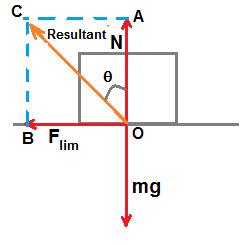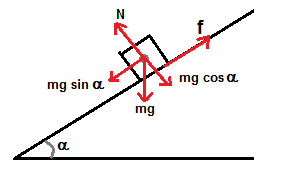Ask questions which are clear, concise and easy to understand.
Ask QuestionPosted by Anshika Bharti 5 years, 3 months ago
- 2 answers
Soumili De 5 years, 3 months ago
Posted by Sunmathi Ramesh 5 years, 3 months ago
- 2 answers
Yogita Ingle 5 years, 3 months ago
Adiabatic Processes
- Adiabatic is a process in which there is no heat flow takes place between the system and the surroundings.
- These processes are sudden.
- The walls of the container should be adiabatic
- For an adiabatic process of an ideal gas
Shivali Thakur ? 5 years, 3 months ago
Posted by Rintei Hmar 5 years, 3 months ago
- 1 answers
Meghna Thapar 5 years, 3 months ago
Addition of vectors satisfies two important properties.
- The commutative law, which states the order of addition doesn't matter: a+b=b+a. ...
- The associative law, which states that the sum of three vectors does not depend on which pair of vectors is added first: (a+b)+c=a+(b+c).
- Triangle law of vector addition states that when two vectors are represented as two sides of the triangle with the order of magnitude and direction, then the third side of the triangle represents the magnitude and direction of the resultant vector.
Posted by Nishant Kumar 5 years, 3 months ago
- 1 answers
Soumili De 5 years, 3 months ago
Posted by Yanshika Choudhary 5 years, 3 months ago
- 0 answers
Posted by Sathi Gupta 5 years, 3 months ago
- 5 answers
Deepak Chaudhary 5 years, 3 months ago
Yogita Ingle 5 years, 3 months ago
Circuit, cell, bulb, switch... Find out about the electrical terminology your primary-school child will be using in the classroom and try some hands-on activities to support learning about electricity at home.
Electricity can be created in a variety of ways such as:
- burning fossil fuels (oil, gas, coal) at power stations,
- using wind power generated by wind turbines,
- using solar power generated by the sun,
- using water power (sometimes called hydropower) generated by running or falling water.
Electricity is transported to our homes, schools and places of work through wires and cables.
Electricity can also be stored in batteries (sometimes called cells).
Posted by Shrajal Vishwakarma 5 years, 3 months ago
- 2 answers
Jai Adithya 5 years, 3 months ago
Jasmeen Kaur 5 years, 3 months ago
Posted by Satyajit Kumar Nath 5 years, 3 months ago
- 3 answers
Harshree Saraf 5 years, 3 months ago
Yogita Ingle 5 years, 3 months ago
The forces which we see in our day to day life like muscular, friction, forces due to compression and elongation of springs and strings, fluid and gas pressure, electric, magnetic, interatomic and intermolecular forces are derived forces as their originations are due to a few fundamental forces in nature.
Posted by Darshna Yadav 5 years, 3 months ago
- 1 answers
Meghna Thapar 5 years, 3 months ago
The coefficient of restitution (COR), also denoted by (e), is the ratio of the final to initial relative velocity between two objects after they collide. It normally ranges from 0 to 1 where 1 would be a perfectly elastic collision. The coefficient of restitution depends to a large extent on the nature of the two materials of which the colliding objects are made. It is also affected by the impact velocity, the shape and size of the colliding objects, the location on the colliding objects at which the collision occurs, and their temperatures.
Posted by Darshna Yadav 5 years, 3 months ago
- 1 answers
Yogita Ingle 5 years, 3 months ago
From v=u+at,v1=0+at1
∴a = v1/t1
F=ma=mv1/t1
Velocity acquired in t sec=at=v1/t1 t
Power=F×v= mv1/t1 ×v1/t1 t=mv12/ t12t
Posted by Shiva Yadav 5 years, 3 months ago
- 2 answers
Yogita Ingle 5 years, 3 months ago
Supplementary units are the dimensionless units that are used along with the base units to form derived units in the International system. The class of supplementary contains only two purely geometrical units, that is the radian and the steradian.
Posted by Shailesh Maurya 5 years, 3 months ago
- 1 answers
Meghna Thapar 5 years, 3 months ago
Photons are electrically neutral. Photons have no mass, but they have energy E = hf = hc/λ. Here h = 6.626*10-34 Js is a universal constant called Planck's constant. The energy of each photon is inversely proportional to the wavelength of the associated EM wave. The energy associated with a single photon is given by E = h ν , where E is the energy (SI units of J), h is Planck's constant (h = 6.626 x 10–34 J s), and ν is the frequency of the radiation (SI units of s–1 or Hertz, Hz)
Posted by Shubham Kumar 5 years, 3 months ago
- 1 answers
Posted by Pallavi Vishwakarma 5 years, 3 months ago
- 0 answers
Posted by Gagan Preet 5 years, 3 months ago
- 2 answers
Manpreet Kaur 5 years, 3 months ago
Yogita Ingle 5 years, 3 months ago
The tendency of a body to continue in its state of motion is called inertia of motion .
Example: Rider Falls forwards when a galloping horse stop suddenly. When the horse stops, the Rider on account of inertia of motion, continues moving and hence falls in forward direction.
Posted by Gagan Preet 5 years, 3 months ago
- 1 answers
Yogita Ingle 5 years, 3 months ago
Following are the different methods that are used for reducing the friction:
- For objects that move in fluids such as boats, planes, cars, etc, the shape of their body is streamlined in order to reduce the friction between the body of the objects as the fluid.
- By polishing the surface, as polishing makes the surface smooth and friction can be reduced.
- Using lubricants such as oil or grease can reduce the friction between the surfaces.
- When objects are rolled over the surface, the friction between the rolled object and surface can be reduced by using ball bearings
Posted by Gagan Preet 5 years, 3 months ago
- 1 answers
Yogita Ingle 5 years, 3 months ago

Angle of Friction beween any two surface in contact is defined as the angle which the resultant
of the force of limiting friction Flim and normal reaction N makes with the direction of normal reaction N
as shown in figure. It is marked in the figure as θ.
The value of angle of friction depends on the material and nature of surfaces in contact.
It can be seen from figure, tanθ = AC/OA = Flim / N = μ , where μ is coefficient of limiting friction

The angle of repose or angle of sliding α is defined as the minimum angle of inclination of a plane
with the horizontal such that a body placed on the plane just begins to slide down.
Its value depends on the material and nature of the surface in contact.
from the figure it can be seen that, f =mg sinα ...............(1)
N = mg cosα ....................(2)
hence we get, f / N = tan α = μ
Posted by Gagan Preet 5 years, 3 months ago
- 1 answers
Yogita Ingle 5 years, 3 months ago
Frictional force causes a lot of losses in general upkeep and wear and tear of machinery. Hence it is considered as a evil. But almost all crucial tasks cannot be carried out without the presence of friction. Basic activities like walking and writing on a surface are possible due to friction. Hence it is considered as a necessary evil .
Posted by Aarohi Singh 5 years, 3 months ago
- 0 answers

myCBSEguide
Trusted by 1 Crore+ Students

Test Generator
Create papers online. It's FREE.

CUET Mock Tests
75,000+ questions to practice only on myCBSEguide app
 myCBSEguide
myCBSEguide